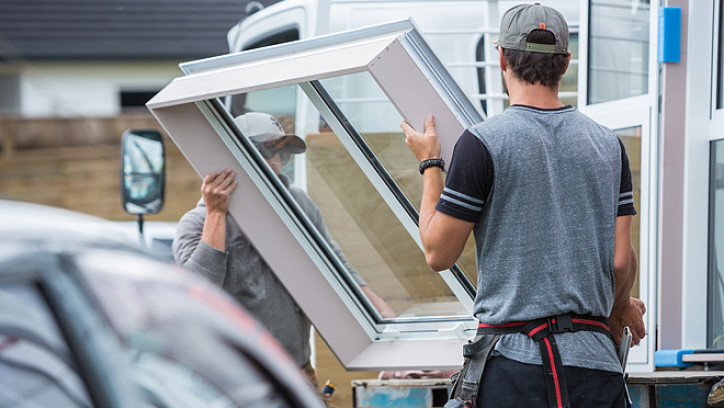Window and door frames
Last updated: 9 August 2023

Different types of frames have different heat transfer, strength and weathertightness properties.
Windows, door and skylight joinery
Frames are an essential part of the performance of your windows, skylights and glazed doors. The type of frame will affect the overall energy efficiency of your glazed areas and how big your windows can be.
If you are renovating an existing home, you may be able to retrofit double glazing into some types of existing wooden or aluminium frames.
Make sure you choose frames with good insulation properties to go with your double or triple glazing – otherwise, you will lose heat through your frames.
Framing materials
Aluminium frames
Currently aluminium is the most common framing material in New Zealand. While it is light, strong, durable and low maintenance, it is a poor insulator (metal conducts heat).
If you choose aluminium framing products, opt for thermal breaks (which place insulation between the interior and exterior part of the frame) or combine aluminium with other materials.
Some existing aluminium frames may be able to be retrofitted with double glazed panes depending on the profile – check with the frame manufacturer or a glazing professional.
Timber frames
Timber is a good insulator and a traditional framing material. Timber may need to be treated and painted for durability, and to reduce swelling and shrinkage when exposed to rain, condensation and sun. It needs regular maintenance.
Existing timber frames that are still in good condition may be suitable for retrofitting double glazing units. This typically involves routing out the frame to make a deeper space for the panes to sit in, and strengthening to ensure the frame is strong enough to take the extra weight.
Composite timber-aluminium frames
Composite timber-aluminium windows are better insulators than aluminium. Aluminium sits outside and is joined to the internal timber facing with a moisture barrier. They combine the benefits of aluminium framing with a timber look for inside areas.
uPVC frames
uPVC windows are made from unplasticised polyvinyl chloride, which is a good insulator. It is light, low maintenance and steel-reinforced for strength. The use of uPVC is growing in New Zealand as it becomes more readily available and affordable.
At present there are limited recycling options for uPVC construction waste in New Zealand.
Fibreglass frames
Fibreglass frames are strong, light and a good insulator. They are particularly suitable for big windows and triple glazing. Fibreglass requires little maintenance, is very durable and can also be recoated.
Steel frames
Steel has largely been replaced by aluminium except for fire-rated windows and heritage building renovations.
Glazing and glass options has more information about the performance of different combinations of glazing and frames. It also includes a rundown on the measures of performance used in window manufacturers' literature and what they mean.
Ventilation
Effective ventilation depends to a significant extent on the size and placement of windows and other openings. Even if your home has a mechanical ventilation system, windows and other openings play a critical role in enabling you to keep cool in summer.
Some framing systems include built-in air vents, so called 'trickle vents'. These passive ventilation systems allow air circulation while the window is closed, however they often do not provide sufficient ventilation to control odours or temperature.
Side-opening casement windows and top-opening awning windows can be used to direct breeze inside if needed.
Glass or timber louvres can provide ventilation in sheltered areas but they're less airtight than the other options, letting in draughts in windy conditions.
Some framing systems can incorporate insect screens so you can keep bugs out when your windows are open.
It is important to ventilate but not to the extent that it results in draughts. You want to be able to choose when to let air in or out, but not let warm air leak out when you need to be warm.
Stopping draughts has more information.
Safety and security
Alongside tough glass, you'll also need to consider the strength of window and door frames and the window and door hardware when it comes to security.
If you have windows close to floor level or on upper storeys, security stays can help to prevent falls from windows – particularly for children. Security stays on ground floor windows can also help keep opportunistic thieves out when you're airing out the house – many thefts happen when people are at home but in another part of the house.
If a window opens over a path or other traffic area, there's a risk someone might walk or run into it when it is open. Sliding windows might be more suitable than hinged ones in this situation.
Climate/weathertightness
Some types of window and door are more suitable in windy areas. French and hinged doors can be caught by strong wind gusts, unless they are secured by a hook or similar when open. Sliding, folding and stacker doors are less likely to be caught by the wind. Folding doors and windows can rattle in windy conditions – especially as they get older.
Your designer will specify window frames that are suitable for the wind loads and corrosion zone of your site. If you live near the coast, some types of window frames may need more maintenance than others due to salt deposits and abrasion from wind-blown sand. You can ask your designer about the most practical and resilient framing options for this sort of climate.
Character/appearance
Colours and finishes vary with framing type – timber and fibreglass have many options, aluminium has a wide range of colour choices. uPVC is generally limited to white, however some suppliers have foil laminated versions that have a range of colours.
If you're renovating an older home, you may want framing sizes and types that are sympathetic to the original design – for example, wooden-framed windows on an older villa or bungalow. As mentioned above, you may be able to get double glazing retrofitted into existing wooden or aluminium frames.